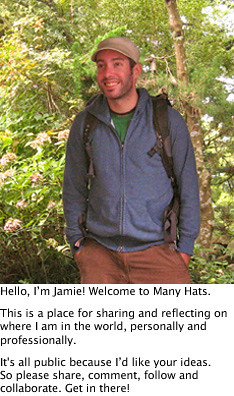Hot Pics & The Attribution Revolution
At first I felt pretty unenthusiastic about this project. I loved that my students were so fired up on research that they would power through online content in pursuit of the perfect image to suit their inquiry. I dreaded the thought of telling them, “Sorry, but all those images you’re been doing awesome things with, forget about them. You’re not allowed to use them anymore”. My heart told me, “c’mon. This is a school. These kids are seven. Anything they do should be considered fair use. The most important thing is that they’re able to purposefully search out research content, and effectively use it to share their ideas.” I still believe this is true. I do think that this is the most important thing. And I believe that at a second grade level we have a degree of fair use latitude that does and should diminish later in education.
But the more I developed this lesson, the more I thought it just might be a catalyst for some really interesting discussions and reflection. Moreover, when I started to consider what practices of fair attribution might look like developmentally I let go of the idea of exclusively pushing for standard practices, or shooting for a very clear, high-level of attribution product for all student uses of online content. Attribution at a second grade level could be a very different thing. It might be anything from learning to paraphrase rather than copy, to writing the name of a book you read at the end of your work, and mentioning a website where you found your material. Slowly, I reflected that promoting attribution at a first steps level could be totally valid and constructive learning process for my students.
My idea went like this. First, I sat down as though to read a story to my class, just as I often do, except in this case I’d covered the author’s name on the sleeve with a bit of bright green masking tape and written “By: Jamie Raskin” on it instead.
I knew that my students would instantly cry foul. And they did. Immediately I heard calls of “What?!” “You didn’t write that!”and “Who really wrote the story?”. I played dumb. I asked the students what was wrong. After a few shared their reasons for dissent, I asked them to turn to each other and discuss why they thought it might be wrong to have covered the author’s name with my own. After a minute, I asked them to share their thoughts with everyone and recorded their ideas on the white board.
Their thoughts were fascinating. Some said they thought it was alright to put my name on it, because I was, after all, the one reading the story. Another said if I just took off the word “by” from my label, that would be acceptable. Others thought my name should be nowhere on the book, but others contended as long as I didn’t cover the original author’s name, it was okay for mine to be there too. When one student said something akin to “It’s not fair to pretend something that you didn’t make is by you”, I knew we were in business.
I asked the class if they thought they may have ever used someone else’s work without saying who had created it. Talking through some thinking time, I watched the majority of the class’ hands creep upwards. Sharing examples we eventually hit on using Google Image Search to track down graphics for our research. Some students proclaimed that they had to use this sort of content. If someone didn’t want us to use it, why did they put it on the internet? Our conversation came around to another point. “How can we use people’s work, but do it fairly?”
So that was the next question I put to them, “How could we use people’s work fairly?”
What was amazing was how quickly they hit on the basic premises of attribution. Two ideas. When you use something, say who made it, and also, say where you got it from. At this I introduced the term attribution, and shortly thereafter, mentioned that I knew of a website where we could search for material that the owners said it was okay for others to use in their work. It was time to move to the computers.
I’d introduced attribution as “giving credit” to the author, and this supported the video I now showed them, a great little one-minute animated song about “giving credit where credit is due”. I’d found the clip on YouTube, but it was created by the people behind the site QuestionCopyright.org, as part of their series of “Minute Memes“, short videos which they claim “reframe copyright one idea at a time”.
Next it was time to introduce Creative Commons Search, and how it would enable us to find images that we were allowed to reuse. We did it as a narrative. First, I showed them the Comic Book template that told the story of a mini-research project. We read through the story, right up until the point where we needed to find an image to complete the narrative. Back to Creative Commons Search and we tried a few examples… What if this story were about a squirrel? A mountain? Clogs? In the final box of the template I pointed out where I’d written attributions for the first two images, and we worked together to include appropriate credit for our various examples.
By then, they were ready to bite into it. In cooperative pairs (I nearly always have students work cooperatively on computers when we’re introducing new tools or resources), they came up with what they wanted to research, made their own copies of the template, and got into it. Their examples are gorgeous, take a look (apparently the class is into wolves!):
I’m really happy with how this lesson went in the end. Since this introduction of attribution around a week ago, I’ve seen students repeatedly using Creative Commons to search and supporting each other to credit work appropriately. It’s the tip of the iceberg for fair use practices, but I feel that at a second grade level, it was a small success, and set the ball rolling for that type of thought.
The full lesson plan is available as a Google Doc here.
Related
MY CLASS BLOG
This is my classy, yet personal blog. For my less personal –but perhaps classier– classroom blogs, click here, or here.MANY HATS in your inbox
Subscribe to Many Hats...

many hats by Jamie Raskin is licensed under a Creative Commons Attribution-NonCommercial-ShareAlike 3.0 Unported License.Details… details…
CATEGORIES
@jamieraskin
My TweetsINVASION PROGRESS








































HISTORY
MANY COMMENTS










